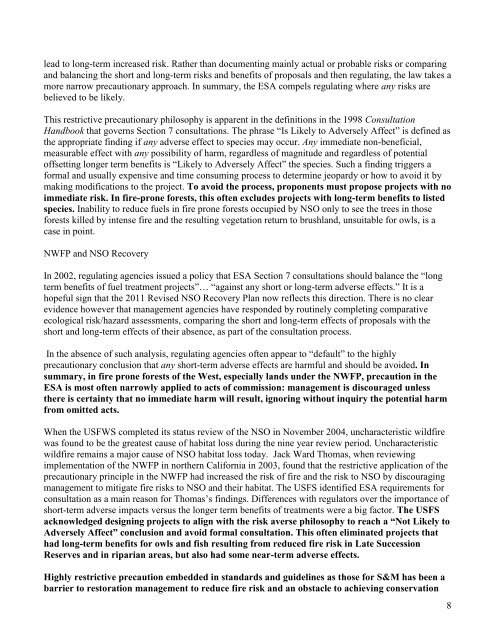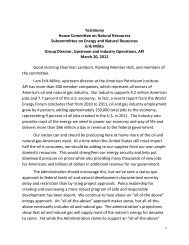Mr. Stephen Mealey - The House Committee on Natural Resources ...
Mr. Stephen Mealey - The House Committee on Natural Resources ...
Mr. Stephen Mealey - The House Committee on Natural Resources ...
You also want an ePaper? Increase the reach of your titles
YUMPU automatically turns print PDFs into web optimized ePapers that Google loves.
lead to l<strong>on</strong>g-term increased risk. Rather than documenting mainly actual or probable risks or comparing<br />
and balancing the short and l<strong>on</strong>g-term risks and benefits of proposals and then regulating, the law takes a<br />
more narrow precauti<strong>on</strong>ary approach. In summary, the ESA compels regulating where any risks are<br />
believed to be likely.<br />
This restrictive precauti<strong>on</strong>ary philosophy is apparent in the definiti<strong>on</strong>s in the 1998 C<strong>on</strong>sultati<strong>on</strong><br />
Handbook that governs Secti<strong>on</strong> 7 c<strong>on</strong>sultati<strong>on</strong>s. <str<strong>on</strong>g>The</str<strong>on</strong>g> phrase “Is Likely to Adversely Affect” is defined as<br />
the appropriate finding if any adverse effect to species may occur. Any immediate n<strong>on</strong>-beneficial,<br />
measurable effect with any possibility of harm, regardless of magnitude and regardless of potential<br />
offsetting l<strong>on</strong>ger term benefits is “Likely to Adversely Affect” the species. Such a finding triggers a<br />
formal and usually expensive and time c<strong>on</strong>suming process to determine jeopardy or how to avoid it by<br />
making modificati<strong>on</strong>s to the project. To avoid the process, prop<strong>on</strong>ents must propose projects with no<br />
immediate risk. In fire-pr<strong>on</strong>e forests, this often excludes projects with l<strong>on</strong>g-term benefits to listed<br />
species. Inability to reduce fuels in fire pr<strong>on</strong>e forests occupied by NSO <strong>on</strong>ly to see the trees in those<br />
forests killed by intense fire and the resulting vegetati<strong>on</strong> return to brushland, unsuitable for owls, is a<br />
case in point.<br />
NWFP and NSO Recovery<br />
In 2002, regulating agencies issued a policy that ESA Secti<strong>on</strong> 7 c<strong>on</strong>sultati<strong>on</strong>s should balance the “l<strong>on</strong>g<br />
term benefits of fuel treatment projects”… “against any short or l<strong>on</strong>g-term adverse effects.” It is a<br />
hopeful sign that the 2011 Revised NSO Recovery Plan now reflects this directi<strong>on</strong>. <str<strong>on</strong>g>The</str<strong>on</strong>g>re is no clear<br />
evidence however that management agencies have resp<strong>on</strong>ded by routinely completing comparative<br />
ecological risk/hazard assessments, comparing the short and l<strong>on</strong>g-term effects of proposals with the<br />
short and l<strong>on</strong>g-term effects of their absence, as part of the c<strong>on</strong>sultati<strong>on</strong> process.<br />
In the absence of such analysis, regulating agencies often appear to “default” to the highly<br />
precauti<strong>on</strong>ary c<strong>on</strong>clusi<strong>on</strong> that any short-term adverse effects are harmful and should be avoided. In<br />
summary, in fire pr<strong>on</strong>e forests of the West, especially lands under the NWFP, precauti<strong>on</strong> in the<br />
ESA is most often narrowly applied to acts of commissi<strong>on</strong>: management is discouraged unless<br />
there is certainty that no immediate harm will result, ignoring without inquiry the potential harm<br />
from omitted acts.<br />
When the USFWS completed its status review of the NSO in November 2004, uncharacteristic wildfire<br />
was found to be the greatest cause of habitat loss during the nine year review period. Uncharacteristic<br />
wildfire remains a major cause of NSO habitat loss today. Jack Ward Thomas, when reviewing<br />
implementati<strong>on</strong> of the NWFP in northern California in 2003, found that the restrictive applicati<strong>on</strong> of the<br />
precauti<strong>on</strong>ary principle in the NWFP had increased the risk of fire and the risk to NSO by discouraging<br />
management to mitigate fire risks to NSO and their habitat. <str<strong>on</strong>g>The</str<strong>on</strong>g> USFS identified ESA requirements for<br />
c<strong>on</strong>sultati<strong>on</strong> as a main reas<strong>on</strong> for Thomas’s findings. Differences with regulators over the importance of<br />
short-term adverse impacts versus the l<strong>on</strong>ger term benefits of treatments were a big factor. <str<strong>on</strong>g>The</str<strong>on</strong>g> USFS<br />
acknowledged designing projects to align with the risk averse philosophy to reach a “Not Likely to<br />
Adversely Affect” c<strong>on</strong>clusi<strong>on</strong> and avoid formal c<strong>on</strong>sultati<strong>on</strong>. This often eliminated projects that<br />
had l<strong>on</strong>g-term benefits for owls and fish resulting from reduced fire risk in Late Successi<strong>on</strong><br />
Reserves and in riparian areas, but also had some near-term adverse effects.<br />
Highly restrictive precauti<strong>on</strong> embedded in standards and guidelines as those for S&M has been a<br />
barrier to restorati<strong>on</strong> management to reduce fire risk and an obstacle to achieving c<strong>on</strong>servati<strong>on</strong><br />
8
















